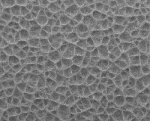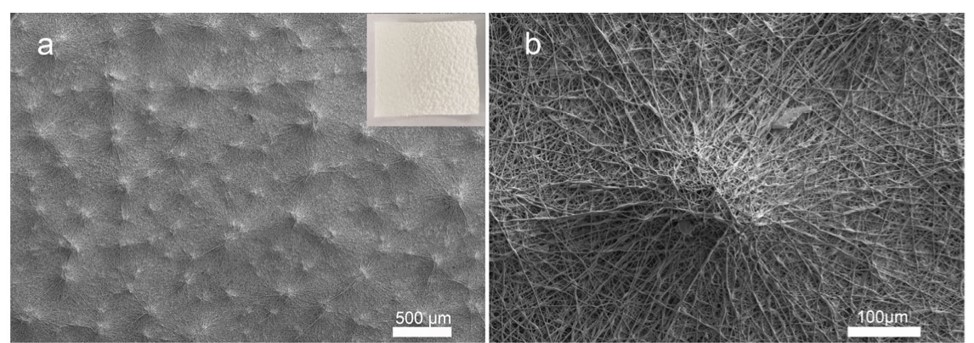Electrospinning sometimes give rise to unusual nanofiber organization and dimpled structure is one of them. Deitzel et al hypothesized that the formation of dimples or honeycomb structure is due to electrostatic charge buildup that prevent later fibers from depositing directly on the collector but instead, suspended slightly above the collector. As the fiber dries and rest on the collector, a dimpled structure is formed [Deitzel et al 2001]. The presence of residual charges on the collected nanofibers seem to be the main cause of the fiber self-organization. Tests using a non-conducting collector such as a cotton substrate showed more self-organization than a conducting collector [Thandavamoorthy et al 2006]. Using polyethylene oxide in distilled water, Liang et al (2013) found that higher solution viscosity reduces the time taken to form dimpled structure. Greater nozzle tip to collector distance also increases the pore size and a polygonal shape fiber distribution can be observed at optimum height which is dependent on the concentration used.
Yan et al suggested that surface tension and electrostatic repulsion accounts for the formation of the dimpled surface. They demonstrated the building up of honeycomb structure with spans from a few micrometers to over 200 um with depths of over 150 um. It was found that wetter fibers tend to form more defined honeycomb structure while drier fibers tend to form structures with some stray fibers straddling across the gap. In their hypothesis, surface tension encourages the wet fibers to stick together while the electrostatic repulsion pushes the fibers apart. When two fibers come into contact, part of the fibers not in contact may be pushed away by the repulsive force [Yan et al 2011]. Since charges are dissipated from the fiber by travelling from one fiber to the other until it reaches the earth, points of contact between fibers will have less charge compared to the other parts of the fiber [Morozov et al 2007]. As a result, incoming fiber will deposit preferentially on these regions of lower charge density. Further, it is easier for the just deposited fiber to line on top of other fibers (due to surface tension). Over time, a honeycomb structure is been built as incoming fiber come into contact with partially wet deposited fiber and the surface tension cause them to stick together. A conducting collector tends to give rise to smaller honeycomb structures due to less retained charges [Yan et al 2011]. This observation is consistent with the results from Thandavamoorthy et al (2006).
Yao et al (2019) conducted a more detailed study to demonstrate the effect of electrospinning condition on the formation of honeycomb structures by polycaprolactone (PCL) fibers. In general agreement with the effect of electric field on honeycomb formation, the honeycomb size varies according to the distance between the needle tip and the collector and the distance of the honeycombs from the center of the collector. At distance further from the needle tip, the electric field weakens and the size of the honeycombs formed by the electrospun fibers become smaller. With a fixed distance between the electrospinning needle tip and collector, honeycomb structures directly below the needle is larger than those further away. Larger distance between the needle tip and collector also led to smaller honeycomb structures. The duration of fiber deposition does not affect the organisation of the honeycomb structure.
A more extreme method of producing electrospun fibers with honeycomb arrangement is to reduce the surface temperature of the collector to below freezing point of water. Tian et al (2023) used a copper collector cooled to -20 °C to induce the formation of ridge-like structure by the electrospun polycaprolactone (PCL) fibers. At room temperature, the electrospun PCL membrane is smooth without any particular structural arrangement. When the temperature was reduced to zero °C, wall-like structure started to form but it is only when the temperature was reduced to -20 °C that ridge-like arrangements were formed throughout the membrane with wider spacings between the fibers. With this setup, the resultant membrane has a smooth underside which was in contact with the collector and a rough surface with the ridge-like structures. It was suggested that with the reduced temperature of the electrospinning environment, solvent vaporization was reduced and the electrical charges carried by the residual solvent encouraged the self-organization of the electrospun fibers.
The electric field condition that encourages the formation of honeycomb fiber organisation seem to be stable even with the build up of insulating fibers on the collector. Yao et al (2019) showed that electrospun PCL fibers start to form honeycomb structure within a minute of electrospinning and the structure remained distinctive at 30 minutes of electrospinning. Study by Thandavamoorthy et al (2006) with non-conducting collector such as a cotton substrate showed more self-organization than a conducting collector thus having the substrate covered by the fibers may not disrupt the honeycomb fiber organization.
Humidity of the electrospinning environment has also been found to influence dimpled nanofiber membrane formation. Liang et al (2014) showed with polyethylene oxide (PEO) solution that the dimpled nanofiber membrane is more pronounced when the relative humidity is at 73% compared to relative humidity below and above that. At lower humidity, PEO solution may dry at a faster rate resulting in drier fibers upon deposition which according to the hypothesis proposed by Yan et al (2011), will reduce the building up of dimpled structures. At higher humidity, the environment is too wet for the deposition of dry PEO fibers as observed by the collection of PEO solution with small amount of fibers. Although humidity has been shown to affect the formation of dimpled nanofiber membrane for PEO, further investigation is needed to show whether it has the same effect on hydrophobic materials since PEO is water soluble.
Formation of dimpled and honeycomb structures have not been widely investigated probably due to the lack of apparent applications. Liang et al (2013) suggest the possibility of using such microstructures as islet for cells although it has not been tested for such application in their study. Such structures are also more commonly observed in beaded fibers [Liang et al 2013] and more investigations are required to determine the range of polymers that demonstrate the ability to form dimpled membranes.
Other microstructures have also been reported to be formed on the otherwise flat membrane by other researchers. Xue et al (2022) observed numerous tiny bumps on the electrospun membrane after 90 min of fiber deposition on a stationary drum collector. These bumps had a diameter of about 200 µm and were made of localised twisted polyurethane fibers while the under surface maintains a smooth and flat profile. Xue et al (2022) hypothesized that these bumps were the result of residual solvents gathering at various spots during evaporation. These semi-wet regions may favor charge dissipation which encourages more fibers to deposit on it. Such a raised profile would further encourage more fibers to deposit on it relative to the neighbouring region and eventually, a raised bump is formed.
Published date: 25 October 2012
Last updated: 28 May 2024
▼ Reference
- Deitzel J M, Kleinmeyer J, Harris D, Tan N C B (2001) The effect of processing variables on the morphology of electrospun nanofibres and textiles. Polymer 42 pp. 261.
-
Liang T, Mahalingam S, Edirisinghe M. Creating "hotels" for cells by electrospinning honeycomb-like polymeric structures. Materials Science and Engineering C 2013; 33: 4384.
-
Liang T, Parhikar M, Edirishinghe M, Mahalingam S. Effect of humidity on the generation and control of the morphology of honey-comb-like polymeric structures by electrospinning. European Polymer Journal 2014; doi: http://dx.doi.org/10.1016/j.eurpolymj.2014.09.020 Article in press
-
Morozov V N, Vsevolodov N N (2007) Electrospray-Neutralization Method for Manufacturing Free and Supported Nanomats. Adv. Mater. 19 pp. 4381.
-
Thandavamoorthy S, Gopinath N, Ramkumar S S (2006) Self-Assembled Honeycomb Polyurethane Nanofibers. J Appl Polym Sci 101 pp. 3121-3124.
-
Tian W, Liu X, Ren K, Fuh J Y H, Zhang X, Bai T, Wu B. Biomimetic Janus film fabricated via cryogenic electrospinning for gastrointestinal mucosa repair. Materials & Design 2023; 228: 111839.
Open Access
-
Xue B, Xie H, Zhao J, Zheng J, Xu C. Flexible Piezoresistive Pressure Sensor Based on Electrospun Rough Polyurethane Nanofibers Film for Human Motion Monitoring. Nanomaterials. 2022; 12(4):723.
Open Access
-
Yan G, Yu J, Qiu Y, Yi X, Lu J, Zhou X, Bai X (2011) Self-Assembly of Electrospun Polymer Nanofibers: A General Phenomenon Generating Honeycomb-Patterned Nanofibrous Structures. Langmuir 27 pp. 4285-4289
-
Yao T, Chen H, Samal P, Giselbrecht S, Baker M B, Moroni L. Self-assembly of electrospun nanofibers into gradient honeycomb structures. Materials & Design 2019; 168: 107614.
Open Access
▲ Close list
 ElectrospinTech
ElectrospinTech


